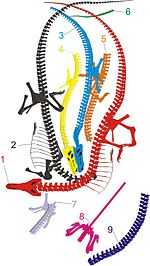Decuriasuchus
| Decuriasuchus Temporal range: Middle Triassic, Ladinian | |
|---|---|
 | |
| Skulls of D. quartacolonia | |
| Scientific classification | |
| Kingdom: | Animalia |
| Phylum: | Chordata |
| Class: | Reptilia |
| Family: | †Prestosuchidae |
| Genus: | †Decuriasuchus França et al., 2011 |
| Type species | |
| †Decuriasuchus quartacolonia França et al., 2011 | |
Decuriasuchus is an extinct genus of prestosuchid rauisuchian from the Middle Triassic period (Ladinian stage). It is a carnivorous archosaur that lived in what is now southern Brazil, in Paleorrota. It was first named by Marco Aurélio G. França, Jorge Ferigolo and Max C. Langer in 2011 and the type species is Decuriasuchus quartacolonia. The generic name means "legion of ten crocodile" in Greek in reference to the ten known specimens and the animal's possible group behavior. The specific name refers to the Quarta Colonia region where the fossils were collected.[1]
Description

Like other rauisuchids, Decuriasuchus was a quadrupedal carnivore that was one of the top predators of its environment. It grew to a length of around 2.5 metres (8.2 ft).[2]
Classification


Decuriasuchus is closely related to the genera Prestosuchus and Batrachotomus. A phylogenetic study of the genus placed it in the family Prestosuchidae, but found the Rauisuchia group to be paraphyletic. The study was based on an earlier 2010 analysis of archosaurs.[3] A later study involved adding Decuriasuchus to a 2011 analysis of archosaur relationships;[4] D. quartacolonia was recovered as the basalmost member of the clade Loricata[5] (the most inclusive clade containing Crocodylus niloticus but not Poposaurus gracilis, Ornithosuchus longidens or Aetosaurus ferratus[4]). As a rauisuchian, Decuriasuchus is a distant relative of modern crocodilians.[1]
Paleobiology

Nine specimens of Decuriasuchus were found in close proximity to each other. A study of the taphonomy of the site (the conditions under which the skeletons became fossilized) indicates that the assemblage represents the single burial of multiple individuals rather than the collection of unrelated remains in one spot over a longer period of time. The congregation of nine individuals in one area suggests that they may have been traveling in a group. If this were the case, Decuriasuchus would be the earliest known archosaur to exhibit group behavior.[1]
References
- ↑ 1.0 1.1 1.2 1.3 Marco Aurélio G. França, Jorge Ferigolo and Max C. Langer (2011). "Associated skeletons of a new middle Triassic "Rauisuchia" from Brazil". Naturwissenschaften 98 (5): 389–395. doi:10.1007/s00114-011-0782-3. PMID 21445632.
- ↑ Talamone, R. (31 March 2011). "Anunciada descoberta de predador mais antigo que dinossauros". Agência USP de Notícias. Retrieved 1 April 2011.
- ↑ Brusatte, S.L.; Benton, M.J.; Desojo, J.B.; and Langer, M.C. (2010). "The higher-level phylogeny of Archosauria (Tetrapoda: Diapsida)". Journal of Systematic Palaeontology 8 (1): 3–47. doi:10.1080/14772010903537732.
- ↑ 4.0 4.1 Nesbitt, S.J. (2011). "The early evolution of archosaurs: relationships and the origin of major clades". Bulletin of the American Museum of Natural History 352: 1–292. doi:10.1206/352.1.
- ↑ Marco Aurélio G. França, Max C. Langer, Jorge Ferigolo (2011). "Incorporating Decuriasuchus quartacolonia (Pseudosuchia) into the archosaur phylogeny". Ameghiniana 48 (Supplement to 4): R63.

